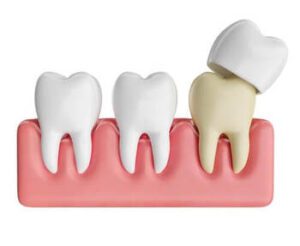Dental veneers have become a buzzword in cosmetic dentistry, offering a solution to many seeking a picture-perfect smile. This transformative procedure enhances smiles globally, but a common question lingers: what do teeth look like under veneers? Let’s delve into the intricate world of veneers to answer this and more.
The Basics of Dental Veneers:

Composition & Materials:
Dental veneers are ultra-thin laminates or shells specifically designed to cover the frontal surface of teeth. Think of them as custom-made, tooth-coloured materials that give teeth a more polished and perfect appearance. The primary materials used in veneers are porcelain and composite resin.
Porcelain Veneers:
Crafted from high-quality ceramic, porcelain veneers are famed for their durability and natural sheen that mimics natural teeth. They are usually fabricated in a dental laboratory, tailored to match the patient’s tooth colour and desired shape. Resistant to staining, porcelain veneers have an edge for those who can’t give up their daily coffee or red wine. The clarity of porcelain’s capacity to reflect light, similar to natural tooth enamel, makes it a favourite for those seeking the most authentic look.
Composite Veneers:
On the other hand, composite veneers are usually directly built up within the mouth and sculpted by the dentist in a single visit. Made from tooth-coloured resin, the same material used for white fillings, these veneers can be an economical and faster alternative to porcelain. However, they might not have the same longevity or stain resistance as their porcelain counterparts.
Application Process:
The application of dental veneers isn’t just a slap-on-and-go procedure. It’s an art, a meticulous process that ensures aesthetic perfection and functional integrity.
Initial Consultation: Before diving into the world of veneers, patients need to have a thorough consultation with their dentist. This allows for assessing oral health, ensuring the teeth and gums are conducive to veneers. Cosmetic dentists may also utilise advanced imaging technology to provide a sneak peek into the expected outcome.
Tooth Preparation: A tiny layer of the tooth’s surface (usually less than a millimetre) is removed to accommodate the veneer. This ensures the veneer bonds correctly and sits naturally without looking bulky.
Impression & Crafting: Post-trimming, an impression or mould of the tooth is taken. This mould is sent to a dental laboratory for porcelain veneers to be crafted. Composite veneers, however, are sculpted on the spot.
Bonding & Finishing Touches: Once the veneer is ready, it’s adhered to the tooth using a special adhesive. The dentist then makes final adjustments to ensure a perfect fit and alignment.
It’s vital to understand that dental veneers aren’t a one-size-fits-all solution, be it porcelain or composite. They are custom-designed, considering individual preferences, tooth shape, facial symmetry, and complexion. Veneers fix one’s smile while ensuring it doesn’t look artificial.
Reasons People Opt for Veneers:
Dental veneers, often considered the “Hollywood solution” for teeth, have grown immensely in popularity beyond the celebrity circle. While they undeniably offer a cosmetic boost, the reasons people opt for veneers are multifaceted, addressing both aesthetic and functional concerns. Let’s explore the myriad motivations driving individuals to seek this transformative dental procedure.
Cosmetic Enhancement:
The promise of a rejuvenated smile is one of the most promising benefits. Porcelain Veneers can drastically improve the appearance of teeth by offering:
Whiter Teeth:
Even good oral hygiene can’t always prevent teeth from discolouring over time. Factors like ageing, medications, or consumption of staining substances (coffee, tea, red wine, and tobacco) can dim the natural brightness of teeth. When traditional whitening treatments don’t suffice, veneers offer a long-lasting solution for a brilliantly white smile.
Uniformity and Symmetry:
Only some are blessed with naturally symmetrical teeth. Veneers can be tailored to provide a balanced, harmonious look, aligning with the patient’s facial features.
Correcting Dental Imperfections:
Beyond mere aesthetics, veneers play a role in rectifying various dental issues:
Chipped, Broken, or Worn Down Teeth: Accidents happen, and sometimes teeth bear the brunt. Veneers provide a seamless cover-up for those with broken or chipped teeth, restoring the tooth’s appearance and function.
Gaps and Spacing: While some might find a diastema (gap between teeth) endearing, others may not. Veneers can be designed to close unsightly gaps, providing a more uniform appearance without bracing.
Misalignments and Irregularities: Mildly crooked or misaligned teeth can be corrected without orthodontic treatment. In such cases, veneers offer an alternative, giving the illusion of straighter teeth.
Reinforcing Weak or Damaged Teeth:
Some individuals have teeth weakened over time, possibly due to excessive grinding, decay, or old, large fillings. While veneers are primarily a cosmetic solution, they can add an extra layer of strength to these fragile teeth, acting as a protective shield.
Confidence and Self-Esteem Boost:
Beyond the physical benefits, there’s an undeniable psychological component. A smile, often the first thing people notice, plays a pivotal role in social interactions. Feeling self-conscious about one’s teeth can lead to reduced confidence, reluctance to smile, or social avoidance. Veneers, for many, are a path to renewed self-assurance, allowing them to smile freely and radiate confidence.
Longevity and Durability:
Veneers, especially porcelain ones, are known for their durability compared to other cosmetic dental procedures. Proper care can last for a decade or even longer, making them an attractive long-term investment in one’s smile.
The Preparation Process:
Achieving a flawless smile with dental veneers requires meticulous preparation. Before that veneer is expertly placed, a series of vital steps ensure its aesthetic appeal and functional fit. Here’s a more concise breakdown of what that entails:
Consultation and Evaluation:
Oral Examination: A thorough check is conducted to identify any potential dental issues. X-rays or impressions might be taken at this stage.
Discussion: The dentist will assess your goals, discuss shade and shape preferences, and introduce the option between porcelain and composite veneers.
Tooth Reshaping and Trimming:
Enamel Removal: A thin layer of tooth enamel is gently removed, making space for the veneer and ensuring a natural appearance.
Comfort Considerations: Local anaesthesia may be used to ensure a comfortable experience.
Impressions and Moulding:
Taking Impressions: After reshaping, an impression of the tooth is captured, serving as a blueprint for crafting the veneer.
Laboratory Crafting: For porcelain veneers, the impression is sent to a dental lab where the final veneer is crafted. Composite veneers are sculpted directly on the tooth.
Temporary Veneers (if needed):
Placement: To protect the reshaped tooth while awaiting the permanent veneer, temporary veneers might be placed.
Under the Veneer – The Revealed Tooth:
Post-trimming, teeth look slightly different. Given removing some tooth enamel, the tooth beneath might appear slightly lighter in shade.
The tooth’s surface becomes smoother, designed for better veneer adhesion. But again, the teeth look far from the horror stories of ‘stumps’ that some imagine.
Concerns and Misconceptions:
Many fear the irreversible nature of enamel trimming. While it’s true, only a minimal amount is removed. Retaining as much natural teeth structure as possible is paramount to maintaining good oral health.
Visit your dentist regularly to ensure everything remains in tip-top shape.
Long-Term Care and What Happens Over Time:
Natural teeth, even under veneers, can be susceptible to decay if not cared for. Maintaining good oral hygiene is crucial regardless of whether one has porcelain or composite veneers.
Over time, with wear and potential accidents, veneers might need replacements. But with care, they can last a long while.
Conclusion:
In the quest for dental perfection, veneers offer a compelling path. However, understanding what teeth look like under veneers and the procedures involved ensures informed decisions. Cosmetic dentists can provide a wealth of knowledge, guiding one to a radiant smile.
At Dental 266, our dedicated team of professionals is eager to guide you on your journey to a radiant smile. Whether you’re considering veneers or have further questions about your dental problems, we’re here to provide expert advice and tailored solutions. Don’t wait to achieve the smile you’ve always dreamed of.
Contact Dental 266 at 02 9051 0600 today and take the first step towards a brighter, confident tomorrow.
References:
https://www.webmd.com/oral-health/veneers
https://www.healthline.com/health/dental-veneers








